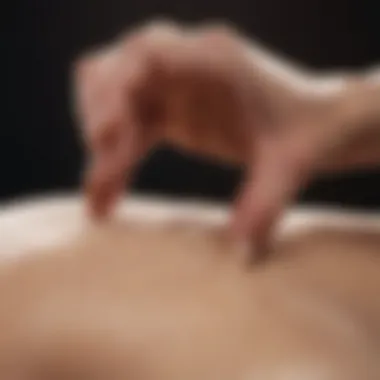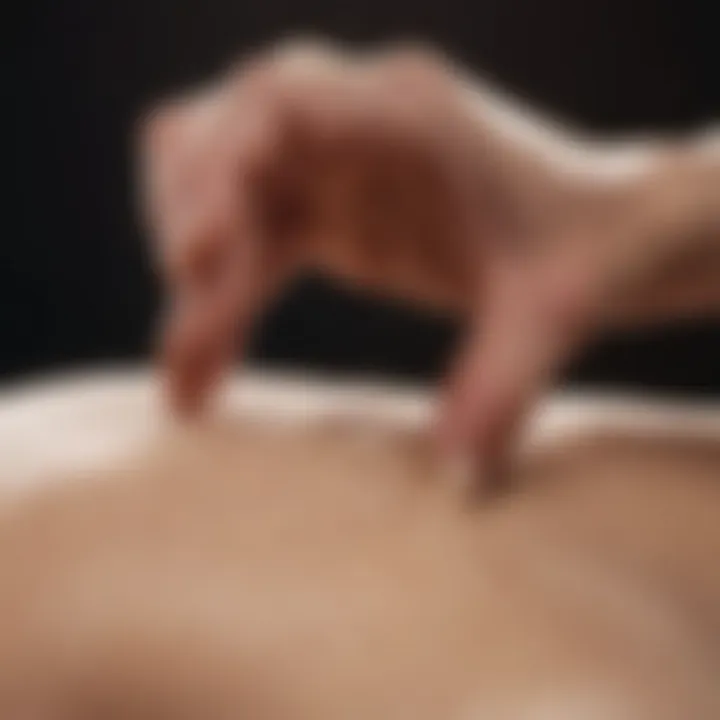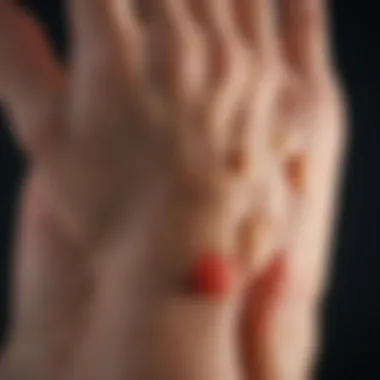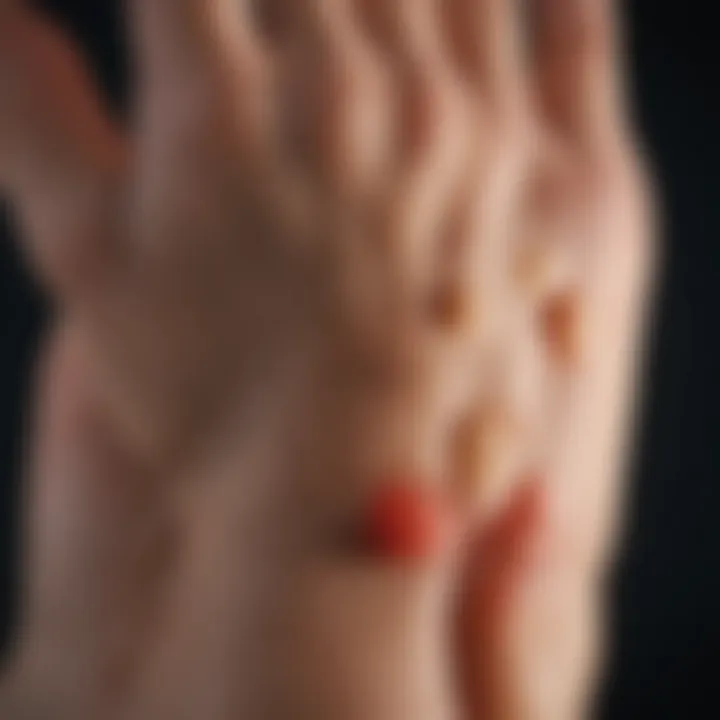Hand Pressure Points: A Natural Approach to Back Pain Relief


Intro
Back pain is a common ailment that plagues many people, leading to discomfort that can hinder daily activities. Whether it stems from poor posture, sedentary lifestyles, or even stress, managing this pain effectively is crucial. One interesting approach gaining traction is the use of hand pressure points. It may seem unusual to think that the hands can influence the back, but the principles of acupressure shed light on this connection.
Acupressure, a traditional healing practice rooted in Chinese medicine, involves applying pressure to specific points on the body to alleviate pain and restore harmony. When we press these points, we stimulate blood flow, promote relaxation, and reduce tension in the corresponding areas. Therefore, understanding how to utilize hand pressure points becomes a valuable tool in managing back pain. This article seeks to delve into this subject, providing insights, practical techniques, and ways to integrate these methods into a daily routine.
Key Concepts
Definition of Primary Terms
Before we dive deeper, it’s essential to clarify a few terms that will guide our exploration:
- Acupressure: A therapeutic technique similar to acupuncture but without needles. It requires manual pressure to specific points on the body.
- Pressure Points: Specific locations on the body that relate to various organs and systems. In the context of hands, these points are believed to influence the back and other areas.
- Back Pain: Discomfort or pain felt in the back that can be categorized into acute, chronic, and referred pain.
Understanding these terms sets the stage for exploring the intricate connection between hand pressure points and back pain relief.
Related Concepts and Theories
Many people might not connect their hands with back pain, but this is where the theory of meridians comes into play. Meridians are channels through which energy flows in traditional Chinese medicine. For example, when you press a certain pressure point in the hand, it can activate pathways that may lead to reducing tension in the back.
Some notable related concepts include:
- Reflexology: A practice where pressure is applied to points on the feet and hands, believed to correspond to different body parts. Reflexology shares principles with acupressure but focuses on different areas.
- Holistic Health: An approach that considers the whole person, including physical, emotional, and mental factors, recognizing that they all play a role in overall well-being.
These concepts help illustrate how interconnected our body's systems are, especially when managing back pain.
Future Directions
While there is a growing interest in the relationship between hand pressure points and back pain relief, some gaps still exist in the research.
Gaps Identified in Current Research
Currently, studies specifically addressing the efficacy of hand pressure points for back pain are limited. Most existing research focuses broadly on acupressure or reflexology without isolating the hand's role. The need for targeted research is crucial for validating the claims made by practitioners and understanding the physiological mechanisms involved.
Suggestions for Further Studies
To broaden the understanding of how hand pressure points can alleviate back pain, more structured studies are warranted. Suggested directions include:
- Longitudinal Studies: Following participants over an extended period to assess long-term effects.
- Controlled Trials: Comparing the outcomes of hand pressure techniques against conventional treatments.
- Qualitative Research: Gathering subjective data from individuals who frequently use these techniques for back pain management.
Closure
By piecing together these components—understanding pressure points, recognizing related theories, and acknowledging future research directions—readers can gain a more profound comprehension of how hand pressure points can play a role in alleviating back pain. This knowledge not only empowers individuals to take charge of their pain management strategies but also opens doors for further exploration in this promising field.
Understanding Back Pain
Understanding back pain is essential for anyone looking to alleviate discomfort and improve overall well-being. Back pain isn't just a symptom; it's a signal that something in the body may not be functioning at its best. The reasons behind back pain can vary widely, from muscle strain and herniated discs to more chronic issues related to posture or lifestyle choices. This comprehensive approach will help illuminate the connection between back pain and acupressure, making it clear why addressing this topic is so vital for effective pain management.
Causes of Back Pain
Back pain can arise from numerous sources. These can include injuries sustained during physical activities, underlying medical conditions such as arthritis, or even simple everyday habits. Lack of movement or incorrect lifting techniques often lead to strain on the lower back, which is particularly sensitive. Understanding these causes is crucial for identifying risk factors and implementing preventive strategies. Factors such as age, weight, and activity level also play a role in how susceptible an individual is to back pain.
Types of Back Pain
Back pain can be categorized into several types, each contributing differently to one’s experience of discomfort. Understanding the distinctions between these types can help inform treatment methods and responses.
Acute Pain
Acute pain is characterized by its sudden onset and sharp intensity. Often the result of an injury or specific event, it serves as a warning to the body. Acute pain usually lasts for a brief duration, often resolving within a few days to weeks. This type's defining characteristic is its ability to provide immediate feedback, prompting individuals to take action. For those dealing with acute pain, exploring acupressure may offer relief from abrupt episodes of discomfort. Techniques focused on relaxation and stress relief can play a significant role in recovery by promoting circulation and reducing muscle tension.
Chronic Pain
Chronic pain, on the other hand, persists for months or even years. It can be a complex issue, often intertwined with both physical and psychological factors. Unlike acute pain, it may not always be effectively managed through traditional treatments. For many, chronic pain can lead to changes in lifestyle, affecting mobility and emotional well-being. Here, acupressure can act as a valuable adjunctive therapy, providing ongoing support to manage symptoms. Utilizing targeted pressure points may improve quality of life by offering a non-invasive way to ease the tension that accompanies chronic pain.
Radicular Pain
This specific type of pain is linked to nerve root irritation that occurs along the path of the nerve. Radicular pain is often felt as sharp, shooting pain that may radiate down the legs or arms. Its nerve-related nature differentiates it from other types of back pain and suggests a more systemic issue. For those experiencing radicular pain, pressure points in the hands associated with nerve pathways could provide relief through stimulating nervous system responses. Targeting these points can assist in easing discomfort derived from nerve compression or irritation.
Localized Pain
Localized pain refers to discomfort confined to a specific area, like the lower back or shoulders. This kind of pain often becomes a significant concern, as it can indicate deeper underlying issues. The advantage here is that localized pain is often more easily identified, allowing for more targeted acupressure techniques. By focusing on the relevant pressure points, individuals can work on alleviating the discomfort more effectively. Such precision can lead to quicker relief and a more personalized approach to managing pain.
Impact on Daily Life


The impact of back pain on daily life can be substantial. Many individuals find that their ability to perform routine tasks is affected, leading to limitations in work, social activities, and even simple functions like sitting or standing. Not only does physical discomfort play a role, but the emotional toll of living with chronic pain can influence mood and productivity.
Understanding these aspects enables individuals to take proactive steps toward management, possibly incorporating techniques like acupressure into their daily routine. By addressing the root causes and types of back pain, one can foster a holistic approach to healing.
Acupressure: An Overview
Acupressure is more than just an alternative healing method; it's a blend of theory, practice, and centuries of tradition that offers profound benefits for pain relief, especially back pain. It operates on the premise that our body is interconnected, and that applying pressure to specific points can result in physical, emotional, and mental harmony. Within the context of this article, understanding acupressure is crucial as it sets the stage for exploring practical applications that target back pain relief.
The elegance of acupressure lies in its accessibility; individuals can engage with these techniques themselves or with guidance, enabling not just alleviation of symptoms but fostering self-care customs in their routines. This ease of implementation, without the need for complex tools or invasive procedures, is a notable benefit, making it a viable choice for many seeking relief.
Historical Background
The origins of acupressure can be traced back to ancient China. The practice is believed to have developed alongside acupuncture, emerging from the same rich tapestry of Chinese medicine as a means to promote health and alleviate suffering. Traditional practices date back thousands of years, where the meridian theory was first documented in the Yellow Emperor's Classic of Internal Medicine. It proposes that specific pathways in our body carry life energy, called Qi, and obstructing or misdirecting this flow is a primary cause of pain and discomfort.
As time went on, acupressure evolved. In different cultures, similar techniques surfaced, such as shiatsu in Japan and tui na in Chinese medicine, further enriching the practice. What stands out historically is the adaptiveness of acupressure—it borrowed elements and therefore adapted to various healing philosophies across the world.
Principles of Acupressure
At its core, acupressure hinges on specific principles that dictate its effectiveness. These include:
- Energy Flow: The foundational idea is that by stimulating pressure points, one can facilitate the flow of Qi.
- Body Meridian System: Each pressure point corresponds to a specific meridian, a channel that connects different organ systems and affects overall wellness.
- Homeostasis: The pressure applied aims to restore balance in the body, supporting both physical and emotional states.
Practitioners often emphasize the role of the mind-body connection, asserting that emotional well-being can significantly influence physical pain levels. Thus, acupressure fosters a sense of mindfulness, while also directly tackling physical symptoms.
Contrast with Acupuncture
While both acupressure and acupuncture stem from the same philosophical roots, they diverge in methods and applications. Acupuncture involves the insertion of needles into specific points, aiming to influence the body's energy pathways. This direct stimulation can produce rapid changes in the body’s energy flow but requires specialized training and often causes more apprehension due to the use of needles.
In contrast, acupressure utilizes finger pressure, making it accessible to everyone and allowing individuals to perform it on themselves. This aspect brings forth significant appeal, especially in settings where professional acupuncturists are not readily available. Furthermore, the gentle nature of acupressure typically results in minimal discomfort.
"Acupressure is freedom—a key that opens the door to solace without fear of sharp needles or overwhelming therapies."
Each technique has its unique set of benefits, and the choice between them often boils down to personal comfort and preference. By understanding these distinctions, readers gain insight into how to best incorporate these practices into their pain management regimen.
Pressure Points on the Hands
The exploration of pressure points located on the hands is critical in the context of alleviating back pain. These points are believed to act as conduits for energy flow within the body, reconnecting various systems and providing pathways for relief. Incorporating hand pressure techniques not only offers a non-invasive alternative but also empowers individuals to take charge of their pain management.
Understanding how these pressure points operate can lead to improved physical and emotional wellbeing. When applied correctly, the techniques targeting these points can activate or calm the nervous system, promote relaxation, and enhance blood circulation. This not only helps with discomfort in the back but can also improve overall health.
Practicing these techniques may also serve a dual function: facilitating immediate relief while building resilience against future discomfort. With the right knowledge, individuals will find that these pressure points on the hands can be effective tools in combating back pain.
Key Pressure Points
LI4 (Hegu)
LI4, also known as Hegu, is a gem in the treasure chest of acupressure points. It's situated in the webbing between the thumb and forefinger. This particular pressure point is renowned for its ability to relieve various types of pain, including headaches and, more importantly, back pain. The key characteristic that sets LI4 apart is its potential to influence the body's overall energy balance.
The beauty of LI4 lies in its accessibility. It's almost always within reach, making it a popular choice for quick self-application. Pressing this point can trigger a release of endorphins, which may significantly dull back pain. However, it is crucial to note that some individuals may experience temporary discomfort during application. Despite this, the benefits often outweigh the initial discomfort, making LI4 a well-recognized option for those managing back pain.
PC8 (Laogong)
Moving on to PC8, known as Laogong, one finds a pressure point located in the center of the palm. It has a key role in emotional healing and stress relief, which can indirectly alleviate physical pain, including that in the back. This attribute makes PC8 particularly beneficial for individuals whose back pain is exacerbated by stress or anxiety.
What makes Laogong unique is how it marries emotional with physical healing. By focusing on PC8, one can not only alleviate discomfort from aching muscles but also lessen the mental burden associated with chronic pain. While there’s little downside to applying pressure here, be mindful of the intensity. Over-application might lead to soreness — a small price to pay for reduced back pain and increased calmness.
HT7 (Shenmen)
HT7, commonly referred to as Shenmen, sits at the wrist crease on the pinky side. This point is frequently cited for its calming effects, making it a go-to for those needing to ease tension that often accompanies back pain. The standout feature of HT7 is the reputations it holds in both eastern medicine and contemporary practice for promoting relaxation and emotional stability.
The incorporation of Shenmen in acupressure routines specifically targets the mental and emotional blocks that may manifest as physical pain. However, it’s important to be cautious not to apply excessive pressure, as this could lead to temporary tingling or numbness. Although some may find these sensations off-putting, the overall trend is that regular application can cultivate deeper relaxation and diminish back pain over time.
Mapping Pressure Points Effectively
To derive maximum benefits from these pressure points, effective mapping is essential. Understanding the locations clearly can lead to efficient self-treatment. One could consider using resources such as diagrams or videos that visually demonstrate pressure points, ensuring accurate application.
Moreover, it is vital to recognize the feedback your body provides while pressing these points. Listening to your own body can be as important as knowing the technical aspects of where to press. \nIn conclusion, knowing how to locate and utilize LI4, PC8, and HT7 can serve as useful tools not just for immediate pain relief but for long-term management strategies as well.
"Understanding your body’s language through pressure points can be a pivotal step toward effective pain management."
In the next sections, we will delve deeper into how to apply these techniques alongside other complementary approaches for back pain relief.
Mechanism Behind Pressure Points


Understanding the mechanism behind pressure points is crucial for grasping how hand pressure techniques can alleviate back pain. When you apply pressure to specific areas on the hands, you activate a complex interplay of physiological and neurological reactions that can significantly reduce discomfort. This is where the magic happens, and exploring these mechanisms can offer insights into why acupressure is so effective in managing back pain.
Physiological Effects
The body is a beautifully intricate machine. When pressure is applied to certain points, it triggers various physiological responses. Here are some notable effects:
- Increased Blood Circulation: Applying pressure stimulates blood flow in the targeted area. This increase can promote healing by delivering essential nutrients and oxygen to muscle tissues, which can be particularly helpful for those suffering from back pain.
- Muscle Relaxation: Pressure points can induce muscle relaxation by alleviating tension. For individuals with tight or knotted muscles in the back, finding relief in the hands may help reduce overall tension.
- Hormonal Balance: The body releases endorphins as a response to hand pressure techniques. These natural pain relievers can diminish discomfort, promoting an overall sense of well-being.
- Reduced Inflammation: Some studies suggest that acupressure may aid in decreasing inflammation in the muscles and joints, contributing to less pain.
In sum, employing pressure on the hands not only feels good but serves functional purposes that can lead to improved comfort over time.
Neurological Connections
You might wonder how something as seemingly simple as applying pressure to one's hand can influence back pain. This is rooted in the captivating field of neurology:
- Nerve Pathways: The human body has a network of nerve pathways that transmit signals to and from the brain. The stimulation of pressure points can send signals that target areas of discomfort. This connection explains why pressing the right points can result in eased tension in distant parts of the body, including the back.
- Pain Gate Control Theory: This theory posits that non-painful input can close the nerve gates to painful input. By stimulating pressure points on the hands, individuals may distract their brains from pain signals coming from the back, thus diminishing the experience of pain.
- Reflexology Principles: These principles align with the idea that specific points on the hands correspond to various body parts. By connecting these points with the areas experiencing pain, it is possible to tap into a holistic approach, alleviating discomfort in an interconnected manner.
Applying Hand Pressure Techniques
The practice of applying pressure to specific points on the hands is an integral part of non-invasive pain management. Using the right techniques can significantly alleviate discomfort, particularly for those suffering from back pain. By employing these methods, individuals can experience relief without resorting to pharmaceuticals or invasive procedures. This section delves into the techniques involved, emphasizing both self-application and guided methods. Each approach comes with its own merits and limitations, making it crucial to find what resonates best with your personal needs.
Finding the Right Technique
Self-Application
Self-application refers to the practice of using one’s own hands to manipulate the designated pressure points. This approach allows for a personalized experience, where individuals can tailor pressure levels to their comfort. One key characteristic of self-application is its accessibility; anyone can do it at virtually any time or location. Therefore, it tends to be popular among those looking for an immediate, on-the-spot solution to their back pain.
The unique feature of self-application lies in its flexibility. You control the pressure and duration, adjusting as needed based on your body’s feedback. However, a potential downside is that it might not always apply enough pressure, particularly for deep-seated pain. Moreover, some people may struggle to find the right angles on their own.
Guided Techniques
Guided techniques involve following the expertise of someone else, like a therapist or instructor, who demonstrates the necessary steps. This method can provide a more structured and reliable approach to applying pressure to hand points. One key characteristic of guided techniques is the expertise that comes with either a professional guide or instructional resources. This can notably benefit those who are new to acupressure.
A noteworthy aspect of guided techniques is the emphasis on proper form and technique, ensuring a more effective application. However, the downside may be the lack of immediate access; you may need to schedule appointments or find suitable sessions. There may also be a financial consideration involved, as guided sessions might come at a cost, making it less convenient than self-application.
Best Practices for Effectiveness
To maximize the benefits of these pressure techniques, some best practices stand out.
Consistent Pressure
Consistent pressure is vital when applying techniques to relieve back pain. Maintaining even pressure allows for a continual influence on the pressure points, potentially enhancing the pain relief experience. This concept centers around the belief that sustained stimulus can amplify the physiological responses associated with acupressure.
This method is beneficial for establishing a rhythm, allowing individuals to recognize when they’ve reached optimal pressure for relief. However, it may take some practice to effectively gauge what consistent pressure feels like, and inconsistency in application can hinder progress.
Duration of Application
Duration of application relates to how long pressure is applied to a specific point. Research suggests that the longer the duration, the more pronounced the benefits can become. This principle hinges on the idea that prolonged pressure stimulates nerve endings and blood flow, thereby promoting relaxation.
A unique aspect of this practice is that shorter, more frequent sessions may still provide relief, especially for those pressed for time. Yet, finding an ideal duration might require some experimentation. Too short might not yield any benefits, while too long could lead to over-sensitivity or discomfort.
Integrating Hand Pressure into Pain Management
Integrating hand pressure techniques into pain management provides a holistic approach that complements various methodologies intended for alleviating back pain. This method recognizes that pain doesn't merely reside in one location; it's often an intricate puzzle influenced by physical, emotional, and environmental factors.
By considering hand pressure techniques, particularly acupressure, as part of a broader pain management strategy, individuals can harness the body's own healing mechanisms. This technique boosts relaxation and reduces stress, making it easier for individuals to cope with back pain effectively. Additionally, it encourages self-care, empowering individuals to take charge of their well-being.
Complementary Approaches
Physical Therapy
Physical therapy focuses on improving movement and strength, using various exercises tailored to individual needs. This approach complements hand pressure techniques by enhancing overall physical functioning. One key characteristic of physical therapy is its practical application; it often includes stretching and strengthening routines that can indirectly support the benefits derived from acupressure.
The unique feature of physical therapy lies in its personalized programs. Therapists assess individual conditions to craft routines that target specific pain regions. An advantage of this method is its structured nature, encouraging consistency that can lead to improved results. However, the individualized demand can be a disadvantage, as not every individual may have access to professional services.
Medication
Medication often plays a significant role in pain management strategies. This could range from over-the-counter options like ibuprofen to prescription medications for more severe cases. The key characteristic of medication is its ability to offer quick relief. For many, it's a go-to solution when pain becomes unbearable.
However, the unique feature of medication is that it primarily addresses symptoms rather than the underlying causes of pain. While effective for short-term relief, it may not contribute to long-term healing, and over-reliance could lead to potential complications such as dependency. Therefore, integrating this with hand pressure techniques might augment results by addressing both symptoms and triggers.
Exercise Regimens
Exercise regimens can significantly enhance overall health and well-being, providing another layer to pain management. Regular physical activity encourages blood flow, strengthens muscles, and improves flexibility, which are all beneficial for back pain relief. The key aspect of exercise regimens is their preventive nature; consistent exercise can diminish the chances of future pain episodes.


Incorporating exercise with acupressure methods creates a well-rounded strategy. A unique feature of exercise is its adaptability; from yoga to strength training, options are vast, catering to personal preferences. One advantage is the long-term health benefits that extend beyond just pain relief, promoting general fitness. However, a drawback is that some might struggle with motivation or find certain exercises difficult, which may hinder the effectiveness of combining therapies.
Assessing Long-term Effects
Understanding the long-term impacts of integrating hand pressure into a comprehensive pain management approach is essential. Evaluating the effectiveness necessitates looking at changes in pain levels over time as well as improvements in functional mobility and overall quality of life. Furthermore, recognizing how these integrated methods influence emotional well-being is crucial, considering back pain often accompanies psychological stress.
By tracking individual experiences and outcomes, practitioners can refine their methods and potentially lead to enhanced understanding and application of these techniques.
Case Studies and Testimonials
Examining case studies and testimonials offers invaluable insights into the practical application and effectiveness of hand pressure point techniques in alleviating back pain. These narratives showcase real-life experiences and allow us to ascertain the potential benefits and challenges related to these methods. Through individual stories, readers can connect with the material on a personal level, finding hope and validation in shared struggles and triumphs.
Evaluation of Success Rates
Evaluating success rates of techniques used for relieving back pain through hand pressure points can lend credence to the effectiveness of acupressure. A clinical examination of various studies revealed that most users saw a notable reduction in pain levels after a series of sessions. One particular study indicated that participants who engaged consistently with their pressure points exhibited a 70% success rate in finding relief, especially those focusing on LI4 and HT7 points.
The monitoring process usually involves a pre-treatment assessment followed by follow-ups to measure progress. Factors such as frequency of practice and individual willingness to engage often dictate overall success. What's clear is that hearing about the victories—and even the setbacks—of others fosters a more relatable narrative around pain relief strategies, grounding the practice in a reality that many can grasp.
User Experiences with Techniques
The personal experiences shared by individuals practicing hand pressure techniques shine a light on its varied effectiveness. One user from an online forum recounted her journey: "At first, I was skeptical, but after trying LI4 pressure for just a week, I felt a significant change. I can sit for longer without discomfort!" This sentiment echoed across numerous testimonials, highlighting a common thread of gradual but consistent improvement.
Others have pointed out the importance of combining techniques. For example, a clinician noted, "Patient A integrated hand pressure with physical therapy, and not only did she manage to decrease pain, but her overall mobility improved. It’s a dual approach that proved beneficial."
In summary, the anecdotes gathered from various users reveal a tapestry of success, with many noting that patience and persistence are vital. The individual nature of pain and recovery means that experiences differ greatly, yet these testimonials provide a communal backbone, illustrating just how impactful these seemingly simple techniques can be. Aligning with both personal stories and broader success data, practitioners and patients alike can better understand what to expect when utilizing hand pressure points for back pain relief.
Scientific Research and Evidence
Understanding the scientific research surrounding hand pressure points is essential for a comprehensive grasp of how these methods can alleviate back pain. Engaging with rigorous studies adds weight to the age-old practices of acupressure, translating ancient wisdom into modern efficacy. This section examines current research trends, demonstrating the integration of acupressure into mainstream pain management, while also acknowledging the limitations that researchers face.
One major benefit of scientific research in this field is the validation it offers to practitioners and their clients. By backing acupressure with data, individuals are more likely to explore these techniques seriously, viewing them as viable alternatives or complements to conventional medical treatments. The identification of specific physiological changes brought about by pressure point stimulation can provide reassurance, emphasizing that these techniques are grounded in biological responses rather than mere chance.
However, it's crucial to consider that acupressure is a broad discipline, encompassing various techniques and philosophies. This diversity complicates research efforts, as studies may focus on differing aspects of practice, from specific pressure points to holistic application methods.
"Scientific studies transform anecdotal evidence into credible practices, which can enhance patient trust in alternative therapies."
All in all, the interplay between rigorous research and traditional knowledge helps in building a framework where patients and therapists can evaluate the benefits of hand pressure techniques for conditions like back pain.
Current Studies on Acupressure
Recent studies have shed light on the potential benefits of acupressure for back pain relief. Research published in journals such as the Journal of Pain highlights various trials where participants reported significant reductions in pain after engaging in acupressure sessions. These trials often emphasize self-application techniques like utilizing LI4 (Hegu) or PC8 (Laogong) pressure points. In these experiments, participants learned to apply pressure to these points on their own hands and maintained a consistent practice over a set period.
Among the notable findings, one study found that individuals using self-applied acupressure experienced a marked decrease in both acute and chronic back pain when compared to a control group. These results signify a promising avenue for individuals seeking non-invasive methods to manage their discomfort. Furthermore, researchers have documented improvements not just in pain levels but also in related symptoms such as mood disorders, further enriching the argument for more holistic approaches in pain management strategies.
In another research endeavor, brain imaging techniques were employed to observe neurological changes during acupressure sessions. It was noted that stimulation of specific hand points activated brain regions associated with pain perception, reinforcing the idea that acupressure is more than mere placebo; it's a physiological interaction worth exploring.
Limitations of Research
Despite the promising findings on acupressure, several limitations hinder the efficacy of research in this field. One of the primary challenges lies in the subjectivity of pain. Pain is a complex experience, influenced by personal, cultural, and psychological factors. As such, quantifying pain relief across diverse populations can present inconsistency in results. Moreover, many studies have relatively small sample sizes, which can affect the reliability and generalizability of the findings.
Another limitation is the variety of acupressure techniques that can be applied. Research often tends to focus on specific pressure points without a comprehensive understanding of how individual approaches may cater to various types of back pain. Additionally, the breadth of acupressure methods leads to a wide range of protocols and definitions, complicating comparisons between studies.
Moreover, potential placebo effects cannot be ignored. While many participants experience relief, it’s difficult to determine how much of that is due to the act of practicing acupressure versus the expectation of relief through participation. Therefore, more rigorous, large-scale studies with robust methodologies are crucial to clarify these ambiguities.
Ending and Future Directions
As we bring this exploration of hand pressure points and their role in alleviating back pain to a close, it’s crucial to consider the broader implications of what we’ve discovered. Not only does the practice of acupressure offer a non-invasive avenue for pain relief, but it also encourages a holistic approach to health. Individuals seeking to ease discomfort may find significant benefits in integrating these techniques into their routine, potentially improving their quality of life.
Summary of Findings
Throughout this article, we have examined the relationship between specific hand pressure points and back pain relief. Key takeaways include:
- Identified Pressure Points: We highlighted relevant pressure points like LI4, PC8, and HT7, each known for their effectiveness in managing back pain.
- Physiological Mechanisms: The physiological aspects behind pressure point stimulation reveal how these techniques can modulate pain perception and promote overall relaxation.
- Complementary Methods: Incorporating hand pressure techniques alongside physical therapy and exercise regimens serves to create a holistic pain management strategy.
These findings reinforce the idea that back pain relief can be approached from multiple angles, utilizing both traditional and modern methods.
Implications for Practice
The implications of this work extend well beyond personal practice. For healthcare professionals, understanding the benefits of hand pressure points could transform patient care models. Some considerations include:
- Patient Education: Teaching patients how to locate and apply pressure to relevant points on their hands fosters self-care and empowerment.
- Integrative Medicine: This knowledge can inform more integrative approaches to treatment, encouraging collaboration between practitioners of different modalities.
- Ongoing Monitoring: Professional supervision during the initial stages of using these techniques can ensure that patients utilize them safely and effectively.
Areas for further research
While this article provides an overview of the practices and findings related to hand pressure points, several areas warrant additional investigation, such as:
- Longitudinal Studies: Conducting extended studies on the long-term effectiveness of hand pressure techniques on chronic back pain.
- Comparative Research: Studying the efficacy of acupressure versus other pain relief modalities, including pharmacological treatment.
- Mechanistic Insights: More rigorous exploration into the neurology involved in pain perception modification through acupressure.
By pursuing these research avenues, we can deepen our understanding of acupressure and its intersection with pain management, furthering the knowledge base for healthcare professionals and patients alike.



